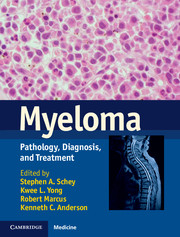Book contents
- Frontmatter
- Contents
- List of contributors
- Section 1 Overview of myeloma
- Section 2 Biological basis for targeted therapies in myeloma
- 4 Cell cycle regulation and myeloma precursor cells
- 5 The genetic and epigenetic mechanisms underlying the behavior of myeloma
- 6 The myeloma bone marrow environment and survival signaling
- 7 Immune dysfunction in multiple myeloma
- 8 Myeloma bone disease – pathogenesis of bone destruction and therapeutic strategies
- 9 Principles of pathway directed therapy
- Section 3 Myeloma: clinical entities
- Section 4 Supportive therapies
- Index
- References
4 - Cell cycle regulation and myeloma precursor cells
from Section 2 - Biological basis for targeted therapies in myeloma
Published online by Cambridge University Press: 18 December 2013
- Frontmatter
- Contents
- List of contributors
- Section 1 Overview of myeloma
- Section 2 Biological basis for targeted therapies in myeloma
- 4 Cell cycle regulation and myeloma precursor cells
- 5 The genetic and epigenetic mechanisms underlying the behavior of myeloma
- 6 The myeloma bone marrow environment and survival signaling
- 7 Immune dysfunction in multiple myeloma
- 8 Myeloma bone disease – pathogenesis of bone destruction and therapeutic strategies
- 9 Principles of pathway directed therapy
- Section 3 Myeloma: clinical entities
- Section 4 Supportive therapies
- Index
- References
Summary
Introduction
Unlike normal terminally differentiated plasma cells, MM cells are capable of self-renewal and proliferation. The direct impact of MM genetics on the expression and function of cell cycle proteins has provided the starting point for recent studies investigating the manner in which neoplastic plasma cells are able to bypass the cell cycle exit that is a pre-requisite for terminal plasma cell differentiation. The search for tumor-initiating “stem” or “progenitor” cells is a current area of intense activity, and multiple myeloma, with its pre-malignant phase (MGUS), its derivation from an memory B cell compartment, and the (sometimes long) periods of disease quiescence termed the “plateau phase” offers unique opportunities to test certain hypotheses regarding these elusive cells. This chapter summarizes the current state of knowledge regarding cell cycle dysregulation in MM, and the existence and properties of myeloma precursor cells.
Cell cycle control
The mammalian cell cycle is tightly regulated through “checkpoints” to ensure that the cell enters S-phase undamaged. The transition between G1 and S-phase is regulated by the interaction between the major G1 cyclins – the D-type cyclins and the cyclin-dependent kinases (CDKs). The three D-type cyclins (D1, D2 and D3) control entry to the cell cycle and are usually induced in response to mitogens i.e. micro-environmental cytokines. D-type cyclins then bind to and activate CDK4 and -6 and these complexes phosphorylate retinoblastoma protein (phospho-pRb), thus allowing S-phase entry by releasing the E2F transcription factors which regulate genes controlling DNA synthesis[1] (Figure 4.1).
- Type
- Chapter
- Information
- MyelomaPathology, Diagnosis, and Treatment, pp. 39 - 47Publisher: Cambridge University PressPrint publication year: 2013

